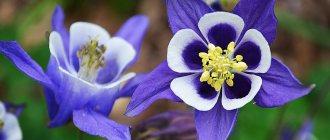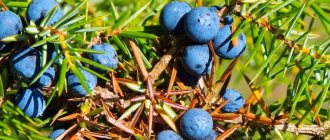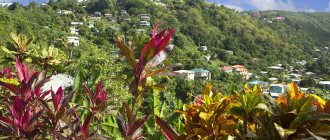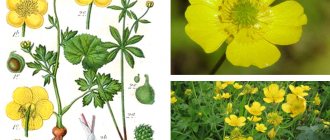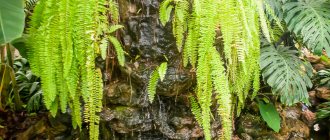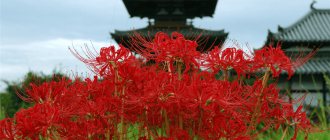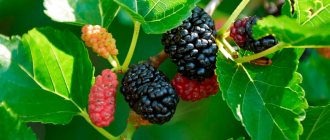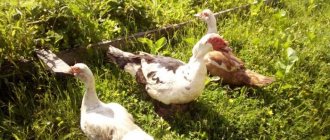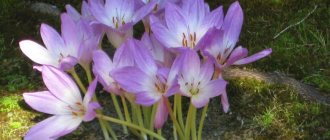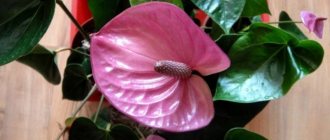Description of the hybrid
The first hybrid group is known as Ismene bent, inclined (Latin Ismene x deflexa) or in another version, characteristic of Russian-language sources, Ismene festive (Latin Ismene x festalis) .
The hybrid was obtained by crossing the long-petalled and narcissistiflora ismene (lat. Ismene longipetala + Ismene narcissiflora). It is very popular in indoor and garden floriculture; it is called “Peruvian daffodil” or “spider lily”.
Belongs to the deciduous bulbous perennials. The ovoid bulb is enveloped in a thin layer of light brown scales. Its average diameter is 10-12 cm. Elongated, up to 50-60 cm, dark green leaves with a width of 7 cm to 10 cm form a false erect stem. The formation of this type of stem is very typical for representatives of the Ismene species.
A single peduncle, bare without leaves, reaches 40 cm in length. From 3 to 6 flowers develop on an umbrella-shaped inflorescence. The perianthium (perianthium) at the base has the appearance of a crown due to fused stamens in the lower part and thin membranes between them. The diameter of the crown is about 5 cm. The crown itself is white, large, with a fringe along the edge.
Imene festalis planting and care ismene festalis photo in the garden
Additionally, six petals are bent in the form of a spider's leg. Yellow-orange anthers rise above the crown of the flower, which has a pleasant fragrant aroma. This hybrid is the basis for breeding work. A distinctive feature of the new variety Zwanenburg is a fairly large bush, the height of which ranges from 80 cm to 90 cm. The flowers, the crown diameter of which reaches 8-10 cm, are large and fragrant. Flowering is observed within 2 weeks in May-June. The flower does not reproduce by seeds due to its sterility.
When crossing Ismene narcissiflora and Ismene amancae from Peru, they formed the interspecific hybrid Sulfur Queen (lat. Ismene hybrids 'Sulfur Queen') . It has already gained popularity and is on sale. Its false stem is pronounced. The bush reaches a height of 60 cm. The fragrant flowers are similar to narcissus flowers. The petals are canary-colored, the crown is deep yellow. The lower part of the stamens has green stripes.
As the flower blooms, its color gradually brightens and at exactly noon it becomes boiling white. Only the inner part of the crown near the striped filaments is yellow. For this feature, the hybrid received two more names: Golden Peruvian Daffodil and Sacred Inca Lily. In the description of the English-born botanist William Herbert, dated 1837, this interspecific hybrid is found under the name Ismene x spofforthiae. The name is unofficial, and the hybrid itself was not famous for its popularity.
Much later, when the Van Tubergen brothers founded a seed and bulb business in Holland in 1868, trials began to crossbreed different species of ismene. The result of this experiment is the most beautiful hybrid varieties, including Sulfur Queen, which has conquered the whole world.
Species diversity of Hymenocallis culture
The genus we are interested in has about 60 plant species. Only a few varieties of the flower are cultivated indoors.
Hymenocallis Caribbean is a bulbous perennial native to the Antilles. It has dark green, wide leaves up to 90 cm long, narrowly lanceolate in shape, and fragrant white flowers in an umbellate inflorescence (from 6 to 12 pieces each) with orange anthers. The peculiarity of the Caribbean plant is that this plant does not shed its leaves all year round and blooms throughout the winter.
Hymenocallis beautiful is the most popular of all types of hymenocallis grown indoors. Its main decoration is an umbrella inflorescence with flowers painted white or yellow.
Hymenocallis is pleasant. Synonym: early hymenocallis. Its origin is also associated with the South American tropics and the Antilles. Narrow belt-shaped leaves of a dark green color, fragrant snow-white flowers collected in umbrella-type inflorescences in the amount of 3-6 pieces, a dense peduncle reaching a height of 70 cm, a bulb whose diameter is within 12 cm - these are the distinctive features kind. The flowering of M. pleasant occurs at the beginning of summer - beginning of September. In winter, the plant sheds its leaves.
Ismene and Hymenocallis: so similar, but still different
The first sign of difference is the presence of a pseudostem in ismene. It becomes noticeable even in a young plant. Hymenocallis leaves grow in the shape of a rosette. At the time of flowering, the stamen filaments of Ismene have a greenish color, which is not observed in representatives of Hymenocallis.
The flowers in the inflorescence are directed to the sides and slightly downward (a horizontal deviation of the peduncle from the peduncle axis is observed). Everything is different for Hymenocallis, since the flowers are directed upward, the peduncle is in a bunch.
Caring for ismena at home and in the open ground
How to care for ismena at home and in the open ground
Temperature
The optimal temperature for the growing season is considered to be +20 ..+23°C. Considering the plant’s dislike for hot weather, when the temperature rises to +28 .. + 30 ° C, flowering bushes are moved to the shade. Storing bulbs during dormancy is recommended at a temperature of +12 ..+14°C, but not lower than +10°C in the same container where the flower was grown.
Lighting
Ismene loves light very much. Therefore, keeping it indoors with windows facing south will be very useful. But we must not forget that in the hottest midday time (12 - 15 hours) it is better to shade it by covering the window with a mosquito net. The plant is afraid of stuffiness no less than sweltering heat. Windows and vents should always be open.
Lack of light affects the appearance of the tree. The bush becomes unnaturally elongated, the pseudostem becomes long, leaning towards the light. The leaves turn pale and yellow. Flowering is inexpressively meager and frail. In such a situation, it is better to plant the flower in the garden, on the leeward side of fruit crops (shrubs). But the place must be sunny.
How to water correctly
During growth and especially during flowering, the plant needs abundant watering. A dried crust on the surface of the soil will be a signal that watering is necessary. During the storage period of the bulbs, watering is limited to once a month and then lightly) at +15..+17°C ambient. If the temperature drops below +15°C, watering is stopped. As for air humidity, Ismena is not sensitive to this parameter and does not need to be sprayed.
Top dressing
There is a complex of special fertilizers and mineral additives for bulbous plants, which can be purchased in specialized stores. On the packaging, the manufacturer gives recommendations for the use of this type of fertilizer and mineral additives at different periods of the growing season of bulbous plants.
As for organic matter, during the period when ismene begins to grow, it can also be used, diluted in a lower concentration than for garden flowers. Fertilizing with organic matter during flowering and after is not recommended. This is the time when the bulb is simply ripening. It does not need enhanced growth and nutrition.
How to Care for a Peruvian Narcissus
There is nothing complicated in caring for an ismena. In order for the flower to feel good and delight with its lush color, it is enough to do the following work:
- Watering. It is important to find a middle ground here. If there is a lack of moisture, the leaves will wither, and if there is too much, they will begin to turn yellow. In addition, when wet, the bulbs quickly rot. Arranging good drainage when planting will help to avoid such incidents.
- Trimming. Peduncles on large bulbs appear in June. The fragrant flowers open one at a time, ensuring continuous blooms for a couple of weeks. Immediately after the buds wither, the flower stalks are cut off.
- Feeding. The first fertilizer in the form of humus is applied when planting the bulbs. Then every 3 weeks the flower is fed with a complex of minerals.
- The bulbs are dug up in September. In this case, you do not need to wait for the leaves to turn yellow. The entire plants removed from the ground are laid out on a mesh for long-term drying. Dried leaves are gradually picked off. The roots are not touched.
- After removing all the leaves, the bulbs are stored in a dry, cool place, such as a basement.
- The following spring, the planting material is removed from storage and replanted in the garden.
Ismene is a very interesting and unusual-looking flower. By planting a bulb, with a minimum of effort and spending very little time, such beauty can be observed in your own garden every season.
How to replant ismena at home and in open ground
How to grow ismene indoors Planting bulbs in a pot
- To replant a plant, you must first prepare the soil. To do this, take: turf and leaf soil in a ratio of 2:1, humus and sand, 1 part each. Ismene prefers neutral soil. The bottom of a large 5 or 7 liter pot is covered with a drainage layer of expanded clay or pebbles (provide holes in advance for draining excess water). Then - the soil.
- The onion for transplantation is planted in a pot, sprinkled with 3-5 cm of soil. After some time, the onion may become bare, which is undesirable. The way out of this situation is to sprinkle fresh soil on top.
If Ismene is planted in the garden , then it must be remembered that the flower does not like either acidic or alkaline soils, or very moist ones. Therefore, it is advisable to add compost before planting in the ground. For airiness, add sand, bark, straw - everything that will not retain water in the soil and form a sticky lump of earth. This is necessary to avoid waterlogging. Ismene is a tall flower, with a strong and dense green mass, which is formed during the growing season, thanks to the optimal conditions created for its growth.
How does a plant reproduce?
Ismene is propagated by children appearing on adult bulbs that have reached the age of four years. During preparation for wintering, small children are not separated from the mother bulbs, because they continue to feed on the adult specimen and gain strength.
Most often, the plant reproduces with the help of children
Important! If you make a mistake and separate the small children too early, they will not be able to independently produce a single leaf capable of feeding an adult flower. Such a bulb will not show any signs of life, simply remaining in the ground in the garden bed.
Strong children are separated in the spring, during transplantation of an adult plant. Young bushes grown from them will bloom in the second or third year.
If adult specimens do not produce children, they are propagated by dividing the bulb into four parts. In some cases, you can try to get flowers from seeds. Planting material is sown almost immediately after receiving it in containers. Five years later, you can see the first flowers of such plants.
Planting ismena in open ground and storing bulbs in winter
Ismene cultivation and care in open ground and at home Ismene bulbs photo
While storing the bulbs, the soil should be dry (limited watering during the dormant period). If the bulbs were dug up for some reason, they should be stored in boxes with sawdust. It is not recommended to trim the roots of the bulb during this period. Higher temperatures during dormancy will cause the bulbs to sprout early, which is undesirable. Ismena should be replanted in previously prepared soil in March. Try not to injure the roots. On the 3rd day after planting, watering the soil is resumed.
If Ismena will be cultivated as a garden plant in open ground , it is necessary to prepare the bulbs in advance. To do this, from the end of March, the bulbs are kept in a room in which the temperature is maintained at +18..+ 20°C. The creation of these conditions is necessary for the bulbs to independently emerge from dormancy and germinate. Compost rotted over the winter is added to the planting soil and flowers are planted in the first ten days of May.
If the soil for planting is quite dry, then take the following actions: heavily moisten the dug hole, add a little sand (dry) or sawdust. Plant an onion in a hole prepared in this way, level it with a layer of dry soil so that it is 2-3 cm higher from the head of the onion.
Preparation for storage
The peduncle is cut off after flowering. Over the summer the bulb will grow well. It must be carefully dug up before the onset of autumn frosts.
Even if it is far from frost and the leaves have not yet turned yellow, the end of September is considered the best time to prepare the bulbs for the winter period. They try to preserve the stronger roots. The newly born children are not touched until spring, they are left together with the mother’s bulb. Do not shake off the stuck soil too much and immediately place the tubers on a mesh base (grid). This is done so that the soil remaining on the roots can crumble. During drying, the leaves themselves will turn yellow and dry out.
Two weeks are enough (for drying) to proceed directly to the storage process. The leaves are trimmed and the bulbs are placed in pots or boxes with dry sawdust.
Rules of care
Watering and air humidity levels
The frequency and abundance of watering depends on weather conditions. With regular heavy rainfall, there is no need to water the flowers. In dry times, the next watering should be carried out only after the top layer of soil has dried out a little.
Water procedures in the form of spraying are not required for flowers.
Fertilizer application
Throughout the season, plants are fed with complex mineral and organic fertilizers, alternately, with an interval of 2 weeks.
It is recommended to use universal fertilizers for bulbous crops and mullein infusion.
Reproduction of ismena
How to propagate photos of children
Daughter bulbs that adhere to the mother bulb serve as material for propagation of the plant. Since the plant bent by seeds does not reproduce, but produces children well, there are times when it does not produce an inflorescence, does not please with its flowering, but fills this gap with numerous offspring.
- The closer the ismena is planted to the surface of the earth, the greater the likelihood that it will not bloom, but will bear offspring. To avoid this, plant the bulb deeper. But do not over-moisten the soil in this place so as not to cause the bulb to rot.
Pest and disease control
Ismene festive Ismene festalis photo Ismene x festalis planting and care
- Whiteflies, aphids, scale insects, and thrips are not averse to settling on the leaves of the plant.
- For those growing indoors, scale insects and whiteflies become a scourge. Remove them using an alcohol solution with a cotton swab. Water with products such as confidor or actara.
- If overwatered or if a flower planted in the garden is exposed to prolonged rainy weather, rot may develop. To avoid this, you need to create conditions so that the soil does not become oversaturated with moisture.
Possible problems during cultivation
The plant has weak immunity and resistance to pest infection. The greatest danger to the flower are aphids, scale insects and thrips. In the early stages of infection, they can be removed with a cotton pad soaked in soapy water.
If the plant is severely damaged, a chemical insecticide should be used, for example Aktara, Aktellik or Confidor.
In conditions of high humidity there is a possibility of bulbs rotting. To avoid this, you should regularly loosen the soil surface and control the watering regime.
The problem can be identified by a decrease in growth rate and the appearance of soft and dark spots on the stem.
When you look at the unusual, unearthly beauty of Ismene’s flowers, it seems as if this plant was somehow miraculously brought from another planet. Indeed, there is something cosmic about it. And yet, this is a bulbous plant of earthly origin; Mother Nature simply endowed it with original, rare boiling white, vanilla-smelling inflorescences, hence the various names: Spider Lily, Narcissus Peruvian, Membrane Flower. So what kind of plant is this – Ismene?


